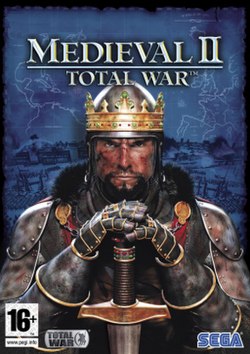Medieval II: Total War
| Medieval II: Total War | |
|---|---|
 |
|
| Developer(s) |
Creative Assembly Feral Interactive (OS X, Linux) |
| Publisher(s) |
Sega Feral Interactive (OS X, Linux) |
| Director(s) | Robert T. Smith |
| Designer(s) | Robert T. Smith |
| Composer(s) |
Jeff van Dyck Richard Vaughan James Vincent |
| Series | Total War |
| Platform(s) | Microsoft Windows, OS X, Linux |
| Release |
Windows
OS X, Linux
|
| Genre(s) | Real-time tactics, Turn-based strategy |
| Mode(s) | Single-player, Multiplayer |
| Aggregate score | |
|---|---|
| Aggregator | Score |
| Metacritic | 88/100 |
| Review scores | |
| Publication | Score |
| Eurogamer | 9/10 |
| Game Revolution | B+ |
| GameSpot | 8.8/10 |
| GameSpy | |
| IGN | (UK) 8.9/10 (US) 8.8/10 |
| PC Gamer (US) | 90% |
Medieval II: Total War, the indirect sequel to 2002's Medieval: Total War and the fourth game in the Total War series from Creative Assembly, is a game of turn-based strategic rounds and real-time tactically-oriented battles, released in November 2006. The game is set between the years 1080 and 1530. Like the original Medieval: Total War, it focuses on medieval warfare, religion and politics in Europe, North Africa and the Middle East.
Similar to previous titles of the Total War series, the game consists of two modes of play: battles and single-player campaign. Battles can be played in multiplayer, in user-defined scenarios, or in historical scenarios which simulate real battles such as the Battle of Arsuf or the Battle of Agincourt. Battles are also featured in the campaign.
The campaign allows the player to assume control of a faction of the time period, and build a civilization, both economically and militarily in order to conquer other factions. Gameplay consists of controlling the faction's military, economic, and social systems in large campaign maps. During the player's turn, armies, fleets, and agents can be moved on the map. When an army engages another army, the player can choose to fight the battle personally in the battle mode, or automatically calculate the outcome.
The goal of the campaign depends on which type of campaign is played. The short campaign requires the player to defeat one or two enemy factions (for example, Holy Roman Empire must defeat its historical enemies Milan and Denmark) and control at least 15 settlements. The long campaign requires the player to control at least 45 territories and one or two significant cities, which are faction specific, such as Jerusalem, Granada, Rome or Constantinople.
...
Wikipedia
